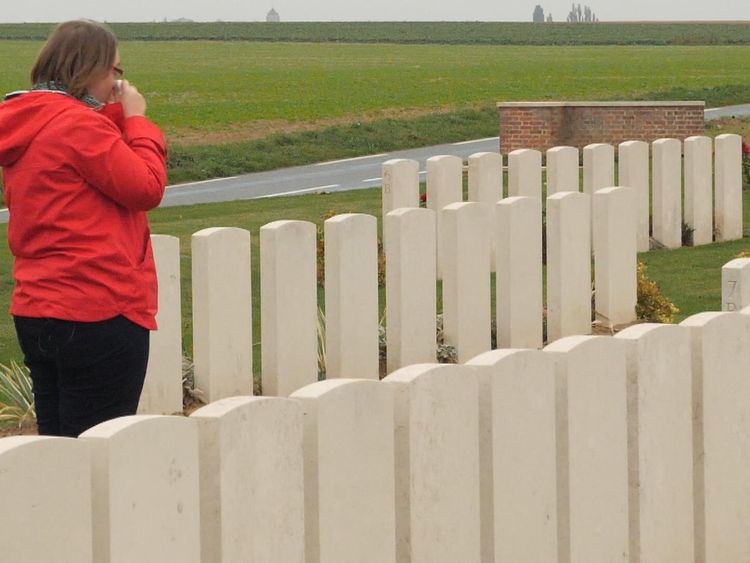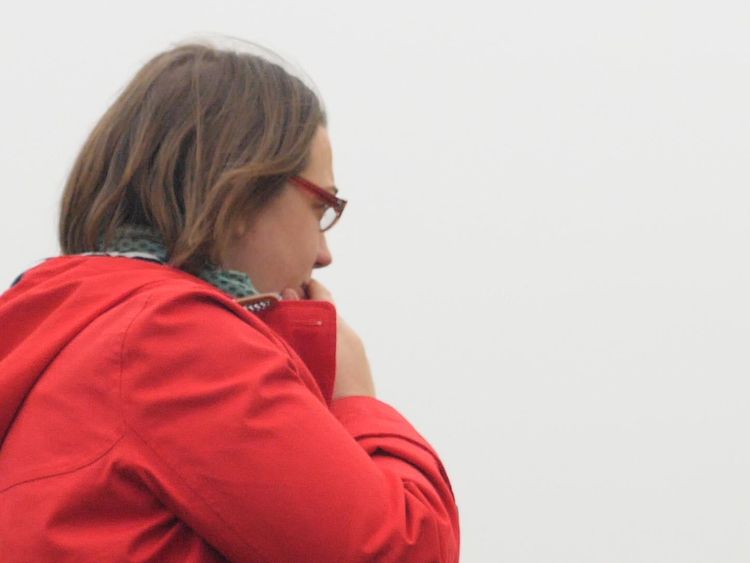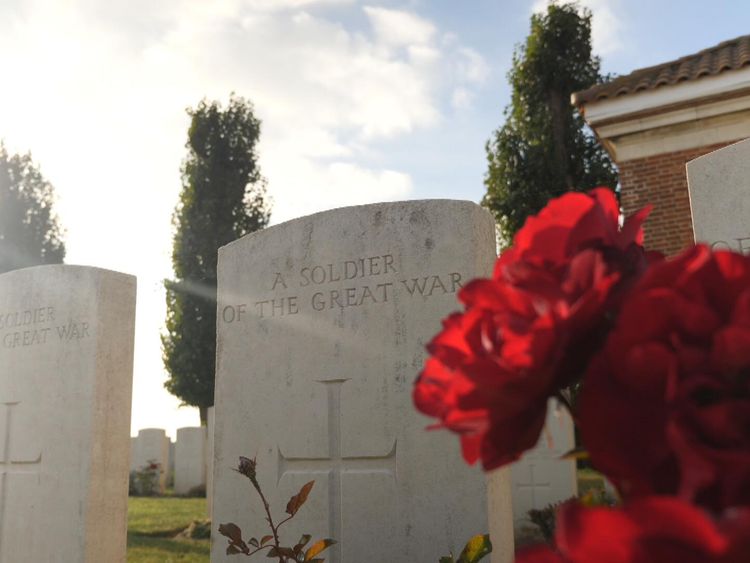Visiting my family's war graves has been invaluable
She took her family to visit them – Charles Young Mitchell, who is buried in France, and Augustus Holland Mitchell, who is buried in Belgium.
Here, she tells Sky News what it was like visiting the graves of her distant relatives.
For over 30 years our family had talked about visiting the graves of our relatives who lost their lives during the First World War… but we never did.
As children we had holidayed in Snettisham, Norfolk, visiting the war memorial in the village and the church, looking at the names of relatives that had passed away, but not really fully knowing their individual stories of how they had come to be commemorated in such a way.
Later, when our first child was born, a girl, it felt fitting to name her Poppy Leigh in tribute.
As an adult I found myself performing the same rituals with my own children; stopping off at Snettisham on our way back home from a day trip to the seaside; observing the minute’s silence on Armistice Day and attempting to explain the complexities of WWI and the parts members of their family had played, despite knowing little of the facts myself.
Earlier this year I became aware of the Snettisham 45 project. I introduced Poppy (now aged nine) to the website and she read eagerly about her great-great-great-uncles Charles and Gus Mitchell – where they lived, what regiments they belonged to, and when and where they had died.
She began asking questions, which led to further research, conversations over dinner and the whole family becoming re-enthused about finding out more details.
I contacted the people organising the Snettisham 45 project to say thank you for all of their work, little realising that within months this would result in us as a family visiting both France and Belgium.
As we drove in the car towards the Honourable Artillery Company Cemetery outside of Arras, the children began to point out cemeteries, (easily identified by the Cross of Sacrifice).
Poppy commented on how many there were and how similar they appeared.
I felt nervous.
I knew where we were going, even what it looked like, as I’d seen photographs, but I wasn’t sure what my reaction would be.
H.A.C Cemetery, Ecoust St-Mein, is situated on raised ground.
We walked up the steps carrying our poppy crosses, wreaths of Norfolk lavender and letters in hand.
What first struck me was the uniformity and scale of the site, and the difficulty this presented in finding the grave we were looking for.
I felt lost at where to begin, having travelled all the way to France, the prospect of finding Charlie’s grave felt no closer.
As we walked the rows of burials the children began to read the ages of the soldiers that lay there.
We all agreed that it was incredibly sad, not only had so many people died, but also that they were very young.
Some not much older than children themselves.
Many of the headstones had the same dates, indicating that many of the men would have been fighting together.
The sense of loss was overwhelming and I began to cry.
Charlie had been 27 when killed in action in 1918; we reflected on how he was just starting out in life, newly married but yet to have children. Upon identifying Charlie’s burial we stood and spoke of his life, about the things we did know for certain, the things the children wanted to find out. But we understand that much of what had happened will remain unknown.
Jon and the children continued to look around the site allowing me a few moments to gather my own thoughts.
As I looked around I was very aware of how much the scenery reminded me of Norfolk.
This gave me some comfort.
I also thought of my father who had passed away some years before.
He never made this visit, and will never know the stories uncovered as part of this project.
But I’ve now been able to share them with my children in the hope that they pass this information on to their children.
Later that day we drove to Rifle House Cemetery, Ploegsteert, Belgium; to pay our respects at the burial of Augustus (Gus) Mitchell.
Gus had drowned in 1915.
We knew no details and could only speculate as to what may have happened. He was recorded as being 22 at the time and engaged to be married.
Rifle House Cemetery, although still maintained by the Commonwealth War Graves Commission, has a very different atmosphere to that of H.A.C Cemetery.
The H.A.C Cemetery Ecoust St-Mein is situated on a roadside and is very open; Rifle House Cemetery on the other hand is very secluded, accessed via a single access track deep in Ploegsteert Woods.
This felt fitting as both Gus and Charlie had been gamekeepers.
I also felt much calmer and more collected at this site, it was much smaller and felt more natural an environment in which to be paying respects to a relative.
We realised during our visit that, in a way, we have many more questions than we did at the beginning of this journey, and that our research would have to continue.
On returning home we discovered many things including that Herbert, the children’s great-great-grandfather, had married a WWI widow, her first husband having lost his life in 1917 at the battle of Scarpe.
The great-uncle I had known growing up, was her child from this marriage.
We also discovered that Charlie had most likely been killed via German machine gunfire and that Gus had drowned while bathing.
Tragically another young soldier had also lost his life attempting to save him.
The visit to the war graves and learning the individual stories of family members has been an invaluable experience for all of us.
The children have been able to explore and get a better sense of their family history and the experiences of those who fought during the war, as well as being able to reflect on the feelings of those that they left behind.
I am sure in years to come we will return to these cemeteries, and I’d encourage other families to do the same.
Source: Read Full Article






